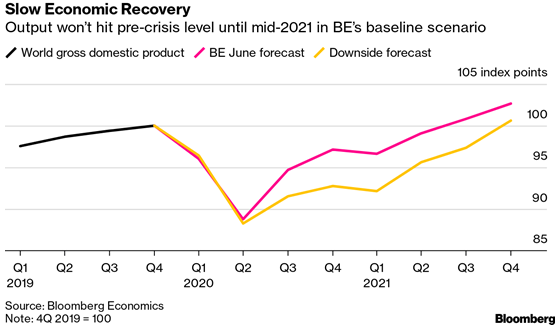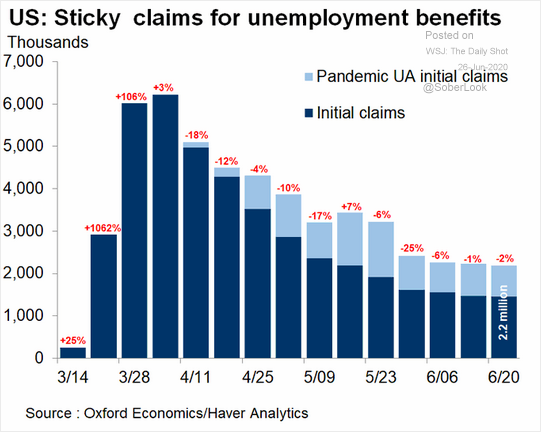COVID-19 Cases Skyrocket, Some Locations Reverse Course on Opening… States such as Texas, Florida, and Arizona, which reopened quickly, are experiencing record infection rates.
What it means— American business owners and consumers are wondering if we can, or should, put the economic genie back in the bottle. Virus hotspots like Houston, Texas, have emerged, with city officials reinstituting mandatory masks for business employees as well as customers. Everyone who doesn’t comply is subject to a $1,000 fine.
Apple closed all its stores across the city. Perhaps not directly related, Microsoft is permanently closing its stores betting on digital sales.
New York, New Jersey, and Connecticut require anyone traveling from states with high infection rates to self-quarantine for 14 days, which is an interesting turn of events, given New York Governor Cuomo’s reaction when Rhode Island asked the same of New Yorkers earlier in the year.

Beyond government limitations, the rising infection rates in the face of increased economic activity could lead to consumers choosing to stay away from stores and restaurants, dampening business. Forty-one percent of businesses listed on Yelp have closed for good during the pandemic. As more companies go bankrupt, it looks like it will be a long, difficult summer. The “V-recovery” will be difficult without active consumers and open businesses.
Existing Home Drop 9.7% in May and Down 26.6% for the Year… Existing home sales dropped to the lowest level since July 2010, during the depths of the housing crisis after the Great Financial Crisis.
What it means— Yes, existing home sales plummeted, but this doesn’t look like the last crisis… yet. Home sales were down significantly at the beginning of the month, but then picked up as states relaxed stay-at-home orders.
Inventory remains tight with only a 4.8-month supply. The key is pricing. Existing homes sold at a median price of $284,600, up 2.3% over last year. That’s not a huge jump, but it’s not a fire sale nor even a discount. There are still plenty of people fortunate enough to keep their jobs who want to buy a home and lock in a 30-year fixed mortgage at 3.00%. In a sign of a possibly strong bounce in June, applications for mortgages to purchase (not refinance), soared to an 11-year high last week.
May New Home Sales Shoot Higher, Up 16.6% From April… The April numbers were revised down by 10%, but the results were still up 12.7% over last May.
What it means— New home sales represent just over 10% of the market, so they aren’t huge, but they do show what buyers are thinking. From the numbers last month, it looks like home shoppers want to buy as quickly as they can. Does this represent urban renters moving to the ‘burbs or just pent-up demand driving sales? Maybe both. Whatever the reasons, home builders are cashing in and enjoying the fact that they’ve not overbuilt since the Great Financial Crisis.
The big question goes back to the first subject this week: how long will home sales rise if the pandemic holds down the economy longer than expected?
Initial Jobless Claims Stuck at 1.5 Million… The number of people filing for jobless benefits for the first time sat near 1.5 million for the third week in a row.

What it means— Lots of people are still trying to get through the narrow door to claim unemployment benefits, showing that job losses continue even as states reopen in phases.
Next Thursday’s unemployment report, ahead of the Friday holiday is important. Getting the majority of those who lost their jobs back to work quickly is key to a quick recovery. With the U.S. logging a record 45,000 new virus cases this past week and the unemployment bonus checks set to run out at the end of July, we’re facing a tough situation in the labor market.
May Durable Goods Orders Jump 15.8%, Most Since 2014, Still Down 21.4% Over Last Year… Transportation orders jumped 80.7% after falling 48.6% in April, which leaves them still down more than 7% from March.
What it means— Core capital goods orders, which are a proxy for business spending, increased 2.3% last month, which made up less than half of the 6.5% drop in April. The report shows that businesses remain exceptionally cautious about the recovery and are hoarding their resources instead of making long-term purchases. That change in psychology, from risk-taking to risk-averse, is likely to be a hallmark of business and banking for at least the rest of 2020, if not through 2021.
Data supplied by HS Dent Research
“When the facts change, I change my mind.
What do you do, sir?” ~ John Maynard Keynes
Our plan is “the plan will change.”
What is your plan?
Relative strength measures the price performance of a stock against a market average, a selected universe of stocks or a single alternative holding. Relative strength improves if it rises faster in an uptrend, or falls less in a downtrend. It is easily applied to individual positions in your portfolio and to sectors and asset classes.
A copy of our form ADV Part 2 is available online.
WARNING: All e-mail sent to or from this address will be received or otherwise recorded by the Investor Resources, Inc. corporate e-mail system and is subject to archival, monitoring and/or review, by and/or disclosure to, someone other than the recipient.
This message is intended only for the use of the person(s) (“intended recipient”) to whom it is addressed. It may contain information that is privileged and confidential. If you are not the intended recipient, please contact the sender as soon as possible and delete the message without reading it or making a copy. Any dissemination, distribution, copying, or other use of this message or any of its content by any person other than the intended recipient is strictly prohibited. Investor Resources, Inc. has taken precautions to screen this message for viruses, but we cannot guarantee that it is virus free nor are we responsible for any damage that may be caused by this message.
Investor Resources, Inc. only transacts business in states where it is properly registered or notice filed, or excluded or exempted from registration requirements. Follow-up and individualized responses that involve either the effecting or attempting to effect transactions in securities, or the rendering of personalized investment advice for compensation, as the case may be, will not be made absent compliance with state investment adviser and investment adviser representative registration requirements, or an applicable exemption or exclusion.

